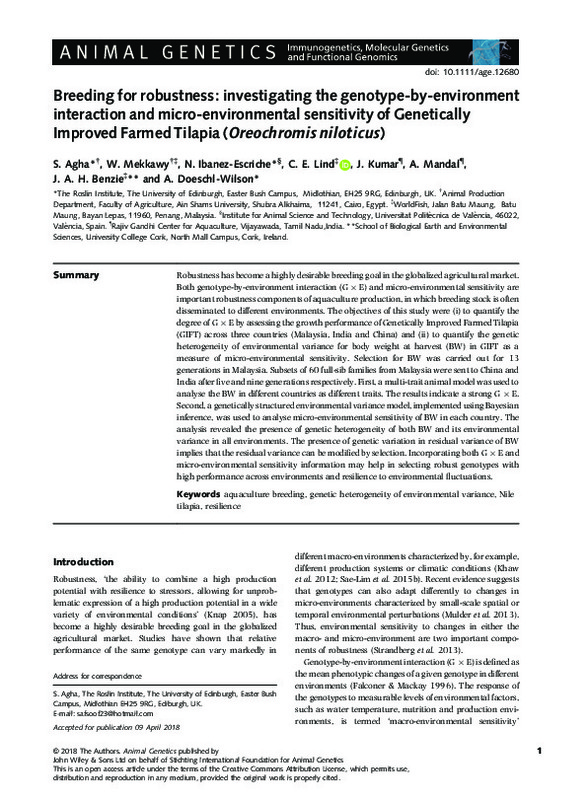Garreau, H., Bolet, G., Larzul, C., Robert-Granié, C., Saleil, G., SanCristobal, M., & Bodin, L. (2008). Results of four generations of a canalising selection for rabbit birth weight. Livestock Science, 119(1-3), 55-62. doi:10.1016/j.livsci.2008.02.009
Gelman, A., & Rubin, D. B. (1992). Inference from Iterative Simulation Using Multiple Sequences. Statistical Science, 7(4), 457-472. doi:10.1214/ss/1177011136
Henderson, C. R. (1975). Best Linear Unbiased Estimation and Prediction under a Selection Model. Biometrics, 31(2), 423. doi:10.2307/2529430
[+]
Garreau, H., Bolet, G., Larzul, C., Robert-Granié, C., Saleil, G., SanCristobal, M., & Bodin, L. (2008). Results of four generations of a canalising selection for rabbit birth weight. Livestock Science, 119(1-3), 55-62. doi:10.1016/j.livsci.2008.02.009
Gelman, A., & Rubin, D. B. (1992). Inference from Iterative Simulation Using Multiple Sequences. Statistical Science, 7(4), 457-472. doi:10.1214/ss/1177011136
Henderson, C. R. (1975). Best Linear Unbiased Estimation and Prediction under a Selection Model. Biometrics, 31(2), 423. doi:10.2307/2529430
HILL, W. G., & MULDER, H. A. (2010). Genetic analysis of environmental variation. Genetics Research, 92(5-6), 381-395. doi:10.1017/s0016672310000546
Ibáñez-Escriche, N., Varona, L., Sorensen, D., & Noguera, J. L. (2008). A study of heterogeneity of environmental variance for slaughter weight in pigs. animal, 2(1), 19-26. doi:10.1017/s1751731107001000
Ibáñez-Escriche, N., Garcia, M., & Sorensen, D. (2009). GSEVM v.2: MCMC software to analyze genetically structured environmental variance models. Journal of Animal Breeding and Genetics, 127(3), 249-251. doi:10.1111/j.1439-0388.2009.00846.x
Janhunen, M., Kause, A., Vehviläinen, H., & Järvisalo, O. (2012). Genetics of Microenvironmental Sensitivity of Body Weight in Rainbow Trout (Oncorhynchus mykiss) Selected for Improved Growth. PLoS ONE, 7(6), e38766. doi:10.1371/journal.pone.0038766
Khaw, H. L., Ponzoni, R. W., Hamzah, A., Abu-Bakar, K. R., & Bijma, P. (2012). Genotype by production environment interaction in the GIFT strain of Nile tilapia (Oreochromis niloticus). Aquaculture, 326-329, 53-60. doi:10.1016/j.aquaculture.2011.11.016
Knap, P. W. (2005). Breeding robust pigs. Australian Journal of Experimental Agriculture, 45(8), 763. doi:10.1071/ea05041
Marjanovic, J., Mulder, H. A., Khaw, H. L., & Bijma, P. (2016). Genetic parameters for uniformity of harvest weight and body size traits in the GIFT strain of Nile tilapia. Genetics Selection Evolution, 48(1). doi:10.1186/s12711-016-0218-9
Misztal I. Tsuruta S. Lourenco D. Aguilar I. Legarra A. Vitezica Z. 2015 Manual for blupf 90 Family of Programs http://nce.ads.uga.edu/wiki/lib/exe/fetch.php?media=blupf90_all2.pdf
Mulder, H. A., & Bijma, P. (2005). Effects of genotype × environment interaction on genetic gain in breeding programs1. Journal of Animal Science, 83(1), 49-61. doi:10.2527/2005.83149x
Mulder, H. A., Veerkamp, R. F., Ducro, B. J., van Arendonk, J. A. M., & Bijma, P. (2006). Optimization of Dairy Cattle Breeding Programs for Different Environments with Genotype by Environment Interaction. Journal of Dairy Science, 89(5), 1740-1752. doi:10.3168/jds.s0022-0302(06)72242-1
Mulder, H. A., Bijma, P., & Hill, W. G. (2007). Prediction of Breeding Values and Selection Responses With Genetic Heterogeneity of Environmental Variance. Genetics, 175(4), 1895-1910. doi:10.1534/genetics.106.063743
Mulder, H. A., Rönnegård, L., Fikse, W. F., Veerkamp, R. F., & Strandberg, E. (2013). Estimation of genetic variance for macro- and micro-environmental sensitivity using double hierarchical generalized linear models. Genetics Selection Evolution, 45(1). doi:10.1186/1297-9686-45-23
Ponzoni, R. W., Nguyen, N. H., Khaw, H. L., Hamzah, A., Bakar, K. R. A., & Yee, H. Y. (2011). Genetic improvement of Nile tilapia (Oreochromis niloticus) with special reference to the work conducted by the WorldFish Center with the GIFT strain. Reviews in Aquaculture, 3(1), 27-41. doi:10.1111/j.1753-5131.2010.01041.x
Robertson, A. (1959). The Sampling Variance of the Genetic Correlation Coefficient. Biometrics, 15(3), 469. doi:10.2307/2527750
Sae-Lim, P., Kause, A., Janhunen, M., Vehviläinen, H., Koskinen, H., Gjerde, B., … Mulder, H. A. (2015). Genetic (co)variance of rainbow trout (Oncorhynchus mykiss) body weight and its uniformity across production environments. Genetics Selection Evolution, 47(1). doi:10.1186/s12711-015-0122-8
Sae-Lim, P., Kause, A., Mulder, H. A., Martin, K. E., Barfoot, A. J., Parsons, J. E., … Komen, H. (2013). Genotype-by-environment interaction of growth traits in rainbow trout (Oncorhynchus mykiss): A continental scale study1. Journal of Animal Science, 91(12), 5572-5581. doi:10.2527/jas.2012-5949
SanCristobal-Gaudy, M., Elsen, J.-M., Bodin, L., & Chevalet, C. (1998). Prediction of the response to a selection for canalisation of a continuous trait in animal breeding. Genetics Selection Evolution, 30(5), 423. doi:10.1186/1297-9686-30-5-423
Sonesson, A. K., Ødegård, J., & Rönnegård, L. (2013). Genetic heterogeneity of within-family variance of body weight in Atlantic salmon (Salmo salar). Genetics Selection Evolution, 45(1), 41. doi:10.1186/1297-9686-45-41
SORENSEN, D., & WAAGEPETERSEN, R. (2003). Normal linear models with genetically structured residual variance heterogeneity: a case study. Genetical Research, 82(3), 207-222. doi:10.1017/s0016672303006426
Strandberg, E., Felleki, M., Fikse, W. F., Franzén, J., Mulder, H. A., Rönnegård, L., … Windig, J. J. (2013). Statistical tools to select for robustness and milk quality. Advances in Animal Biosciences, 4(3), 606-611. doi:10.1017/s2040470013000162
[-]









